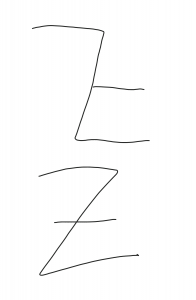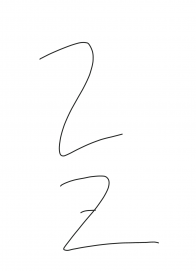Burning questions about teaching English in China #4: A B C D Ƶ F G
This is the fourth in a series of articles about some of the puzzling aspects of teaching English as a Foreign Language in China. You can find the previous entries linked below.

It's so EZ. Top: E as written
by some students. Bottom: Z
as written by some Europeans
Puzzler #4: Why do some Chinese students write "E" with its "hat" on backwards?
Like the misspellings "ture" (for "true") and "konw" for "know", this peculiar way of writing the upper case E has popped up in my classes each year I have taught here. Again, I have no idea why or how some students acquire this habit, because they have all presumably learned the alphabet in primary school. Could it be because some students are naturally left-handed? Is it because of Chinese character stroke order? Have computers and cellphones ruined their penmanship? Or are they just being careless?
Strangely, I have not seen students write uppercase "F" in the same fashion. It's generally written in the standard way, in manuscript form anyway.
[NOTE: For my non-Chinese readers, students here learn the manuscript Latin alphabet, and by high school apparently learn a kind of italic handwriting for English. They do not learn cursive Latin handwriting, which I hear is now true in the USA, as well. I've found that most of my Chinese students have excellent handwriting, much better than mine!]
As with "ture" and "konw," which are just plain wrong and should be abolished in all Chinese media and classrooms, writing "E" with its top stroke pointing to the left needs to be corrected at an early age. First, no one in the world writes it like that, as far as I can tell. Second, it can be confused with the letter "Z," as written by some Europeans. You can see what I mean in the image above. The top letter is how some Chinese students write "E" and the bottom is the "Z" as written in Germany, for example.
Chinese (and American) students, however, learn to write "Z" without that little stroke -- called a serif -- in the middle. So, probably they would not realize their funny-looking "E" could be mistaken for a sloppy "Z."
Why do some people (like your author here) put that serif in the middle of the Z, anyway? It's to avoid confusion with the number "2."

Two is at the top, and Z-
with-serif is at the bottom
While it may be easy to distinguish characters in printed form, when it comes to people's handwriting, it is sometimes not so clear-cut. For example, many Europeans (and even Americans) write "2" as shown in the image here. In most cases, a reader would understand from the context that it's a numeral and not a letter: "Zebra" and not "2ebra" for example. But in math and science, which I used to teach, it's important not to confuse "2" with "Z", so many Europeans (and some Americans like me) add the serif in the middle, as shown in the bottom half of the image.
The "Z-with-a-serif" is so common that it has its own Unicode representation, in fact: either U+ 01B5, & #437; (spaces added so you can see the codes).
But I digress. The key idea here is that Chinese students need to write "E" the way the rest of the world does.
By the way, here's a related puzzler I had, but now I think I have the answer. I've noticed that some students write "9" with the circle part to the right of the vertical stroke. I've learned that students in South Korea and Taiwan are taught this form, apparently. So, perhaps the backwards "9" is also taught on the mainland. Can anyone confirm this?
References:
Wikipedia: Regional handwriting variation
Wikipedia: Z with a stroke
Wiktionary: Z with a stroke
PREVIOUS 'BURNING QUESTIONS' ARTICLES:
He said, she said
Ture or false?
You konw wat?
☀ Post Resteem Service Offer ➡ Re-steem Your New Post ➡ Send 0.400 SBD or 0.400 STEEM To @stoneboy ✉ Post Url in the Memo ✉ Your Post Will Be Re-steem to 7300+2800 followers with 2 different accounts.☺